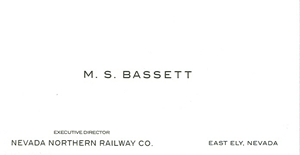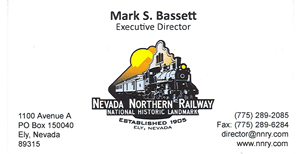The Nevada Northern Railway is a 19th century complex existing in the 21st Century. I’m reminded of this all of the time, like right now when I get a whiff of coal smoke wafting through my office window. Of course, my office window is open because my office is not air-conditioned. The coal smoke is coming from steam locomotive 93 banked and stored in the original enginehouse.
The National Trust for Historic Preservation started a program earlier this year called “This Place Matters.” We’ve adopted that as our theme too, because this complex does matter. A small dedicated staff and a larger devoted volunteer pool work hard to keep the railroad viable in the 21st century and it does have its moments.
Our goal in preserving the railroad is to continue the routines and practices of the Nevada Northern and society as it was during the railroad’s heyday, and this causes problems: railroading and society have evolved (not always for the better, but we’ll leave that argument for another day). The simplest things can become difficult to do if not impossible.
Take business cards for example; should be simple, right? Wrong. I found an original Nevada Northern Railway business card. It is elegant and simple—name, title, company, and location. No phone, cell, or fax numbers; no website, no e-mail, no zip codes, no logos. Simple and straight forward—elegant.
I thought I would mimic the style but I needed to add all of the 21st century paraphernalia. I did and it looked awful. Gone was the simplicity and elegance. The business card looked like I was trying to put 10 pounds in a 5-pound sack.
So what to do? I didn’t want to lose a piece of the Nevada Northern’s history but at the same time what worked 100 years ago wasn’t working today. So a compromise was developed—we have double sided business cards. One side mimics the original card and the flipside is all 21st century—websites, logos and phone numbers galore. And it actually turned out great. That little piece of paper serves as a reminder that we are bridging the 19th century to the 21st century.

Another challenge is coal. Coal was ubiquitous. It powered the Industrial Revolution. It transformed society. That was then. Now coal is under siege. Try buying locomotive coal. We have very specific requirements: 4-inch minus in size; semi-bituminous; low ash; low to medium sulfur; and no slate content. Through the years, the Nevada Northern burned tons of coal for the steam locomotive, steam shops, power plants, steam cranes, and steam powered rotary snowplow. Trainloads of coal came to East Ely.
Now in the 21st century, the tracks are no longer in service to Cobre. So all of the coal we need comes in by truck. Half of the cost of the coal is for transportation costs. And we cannot get exactly what we need. We use what we can get and feel lucky. Our supplier recently upgraded their breakers and guess what? The size we need is no longer made. So we take what we can get and bust the large lumps into smaller lumps with a sledgehammer. We make it work.

For the most part, we have overcome the challenges of the 19th century. But just when we congratulate ourselves on that feat, a new 20th century problem raised its ugly head and it may be unsolvable. NASA has the same problem—outdated electronics. (Who knew a space agency and a historic railroad would have the same problem.)
Our diesel locomotives were built in the late 1940s at the dawn of the age of electronics. They have a mixture of printed circuit boards and mechanical relays. And these parts and their components are no longer made. It is only a matter of time before we suffer a catastrophic electrical problem in one of our diesel locomotives. When that happens (and it will) that might very well be the end of that locomotive. It might not be feasible or possible to rebuild the electrical system. Rebuilding the running gear on a century old steam locomotive was a cakewalk compared to attempting to rebuild sixty-year-old obsolete electronics.
Right now, locomotive 93 is down in front of the depot getting ready to depart. On board is my favorite example of 19th century and 21st century technology working together. When 93 was built a century ago, it was built without a speedometer. To determine speed all crewmembers had a watch and timed the distance between mileposts. Simple and elegant. But then in the 20th Century, the Federal Railroad Administration changed the rules. Steam locomotives would be required to have speedometers.
That was a head scratcher—trying to figure out how to comply with the new rule. We were trying to figure out linkages, levers, counters—it looked like putting speedometers on the locomotives would be one very large headache. Then it was suggested to just put a Global Positioning Satellite (GPS) speedometer on the locomotives.
At first glance this appeared to be a simple and elegant solution—a big plus. GPS controlled speedometers utilize state-of-the-art satellite guidance to determine speed of an object. No linkages, levers, or counters needed—another big plus. But a GPS speedometer needs electricity to work.
When steam locomotives needed to use electricity for headlights and lighting, a method had to be devised to generate electricity from steam. The solution was a steam-powered generator or a “dynamo” as they were known. When operating, dynamos would run around 2400 RPM and generate 32 to 37 volts of direct current electricity.
So we had the pieces. A 19th century steam generator (the steam locomotive) powering a 19th century dynamo (producing electricity.) This in turn is powering a 21st century GPS receiver. That is calculating the speed of a century-old locomotive using satellites in outer space. Quite the combination of technology—old and new.
As we continue our work on preserving this wonderful time capsule, we will have more trials to confront of getting the 19th century, the 20th century, and the 21st century to coexist. As always, it promises to be an interesting journey.

